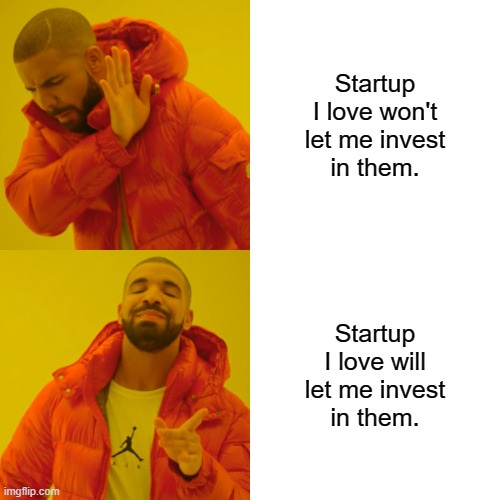TAM
Every B2C startup should let their customers invest in them, alongside VCs.
Community Rounds are still a very nascent concept. The SEC implemented the Regulation Crowdfunding laws that allow anyone (not just rich people) to invest in startups they love in May 2016. But the laws were massively improved in March 2021 – only two years ago. And Wefunder rolled out the term (and the website) “community round” less than a year ago. It’s early days.
From a numerical perspective, Wefunder is running at around $15M of investment volume per month right now. Which is a very small percentage of US venture capital and angel investment volume. EY says that US venture capital investment was $209B in 2022. Which means that Wefunder had a 0.1% market share — of VC along (i.e. excluding angel investors, friends & family, etc.). Lots of room to grow!
Shifting a paradigm is hard. And crossing the chasm is hard. They take time. Some intrepid founders like Immad or Amjad or Sam catch the vision, and are willing to take the leap of faith. But most are a little more timid. They want to see more success stories and case studies before pulling the trigger.
So the growth is linear. And the progress halting. And 2023 is definitely a different market to 2021.
Compound Interest
But every venture-backed (or venture-backable) startup that opens up an allocation to let their customers and community invest is another corroboration, another validation. Momentum starts to build. And the paradigm starts to shift.
In the last couple of years alone, multiple forces have been compounding:
In March 2021, the SEC increased the community round cap from $1M to $5M, and allowed for Special Purpose Vehicles (SPVs) to roll investors up to 1 line on the cap table;
In April 2022, Wefunder rolled out the term “community round”, and less than a year later, it has started to seep into the startup discourse and dialect;
More and more world class startups are choosing to launch community rounds (as an example, I know of at least four a16z portfolio companies that have launched on Wefunder in the last couple of years. Compared to zero in the five years before that);
Wefunder’s product and operational processes have massively improved. Still a long way to go here, but if you zoom out, we’re making significant strides in the right direction;
Our investor base has more than doubled in the last couple of years, which is more eyeballs for founders to get in front of;
Early stage VC funding is a lot harder to come by. Rounds are being done more slowly. And valuations are depressed. As a result, an alternative option – of raising capital from their customers – is increasingly attractive to founders.
I’ve been at Wefunder for five years now. And our pipeline of founders exploring (or actively) launching a community round is the hottest it’s ever been by a distance. In a down market. Before Substack launched.
And however small the “community round” market is today. And however painfully slow it is to effect the paradigm shift, the vision we have for the future is a bold one. And the Total Addressable Market is a large one.
The TAM
In a sentence, the vision (and the TAM) is a world where every venture-backed B2C startup opens up 10-20% of every round to let their customers invest, alongside VCs.
As an aside, other startups can use Wefunder too. B2B companies like Immersed or Mercury have raised $5M community rounds on the platform. And Biotechs like Leah Labs raised capital from hundreds of dog lovers who were excited to be a part of trying to tackle canine cancer. But the sweet spot is consumer-facing companies.
As another aside, the real TAM is actually much bigger than “venture backable businesses”. I think community rounds are a really interesting option for main street businesses like Cassava (a restaurant in SF), or Chattanooga FC (a soccer club in…you guessed it…Chattanooga).
And I don’t really see why every friends and family round shouldn’t be conducted on a Reg CF platform like Wefunder (can publicly promote; easily raise from unaccredited investors; one SPV on the cap table; logistically simple; handling of payments, distributions, etc.; clear, industry-standard investment contracts, etc.).
But even if the TAM is just “a small allocation of venture-backable B2C startups’ fundraising rounds”, that’s a big market to go after. And that’s where we’re headed.




Couldn't agree more and I'm proud to be an investor in Wefunder!